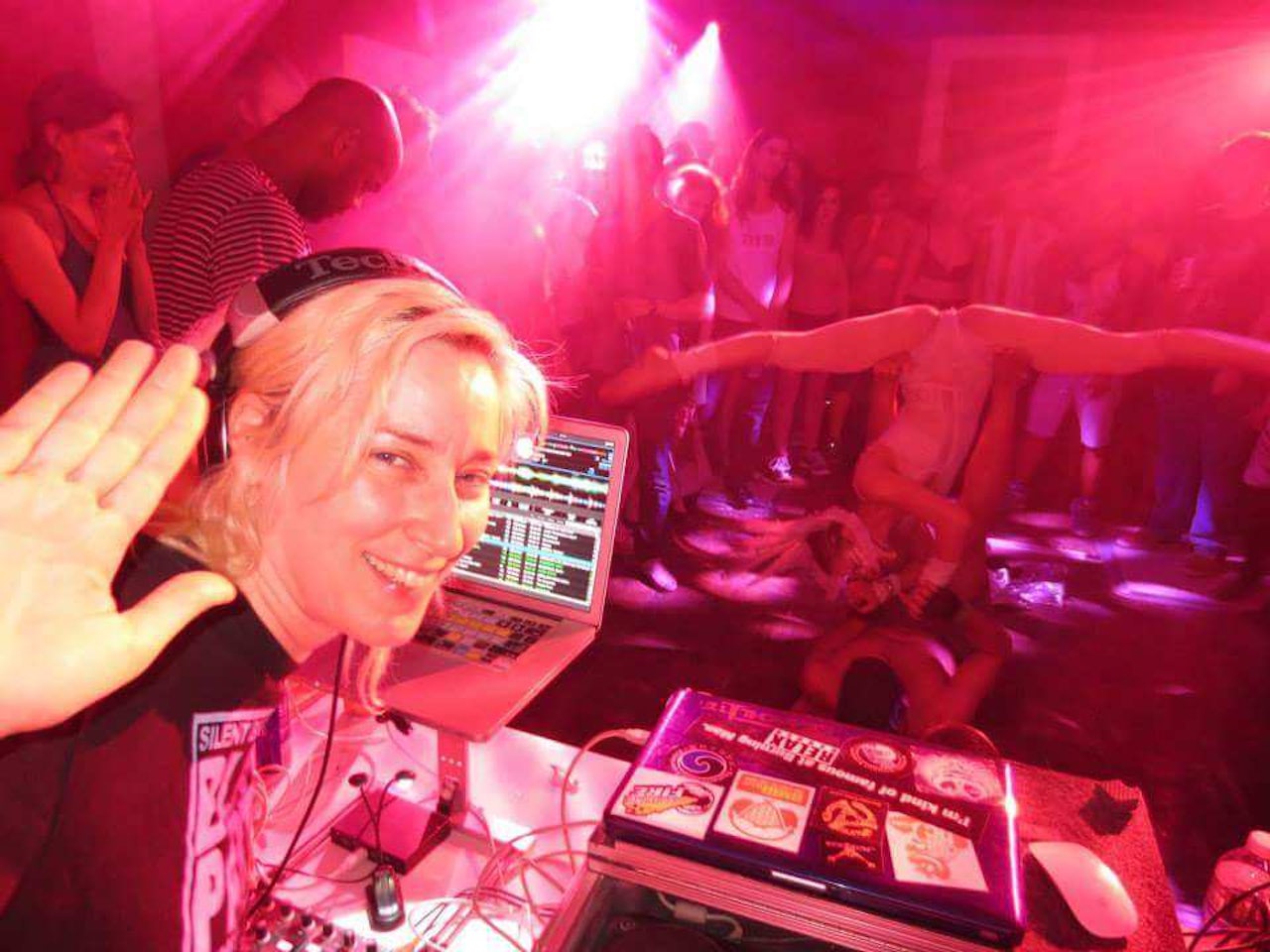Under foot, the human body feels extra gelatinous — especially when you’re simultaneously swapping out CDs, segueing beats, and reading the room, which happens to be filled with men being erotically stampeded. Julie Covello, known as DJ Shakey, had this exact experience at a fetish trampling party, when she played an entire set while balancing on a body. “The human body, it wiggles around,” she said. “It’s like a bag of jello and the skin kind of moves around on the bones. It was pretty tricky.”
Julie’s rotation of gigs includes weddings, festivals, a regular spot at The Keep in Bushwick, and, most intriguingly, a range of play parties. The umbrella of “play” events encompasses a lot of things. There are swinging parties, which are exactly what you think they are; poly play parties, the same concept but for those in polyamorous relationships; orgies for group sex; sex parties where there are designated areas for sex, but sex isn’t necessarily a group activity; pan sexual play parties where no intercourse happens but anything less is acceptable; and porno parties where porn is played on large screens throughout the venue, but still no intercourse. The one most unlike these that Julie also DJs are fetish parties, where there is no sex at all, only people indulging in fetishes like spanking, bubble wrap, and World War II cosplay. (We’re talking pin-up attire and men in uniform, not toothbrush mustaches.)
Play parties saturate New York City in a hidden-in-plain-sight kind of way. If you haven’t been to one yourself, you are probably no more than two degrees separated from someone who has. The layouts of most play parties resemble a catered dinner — they include alcohol, a buffet, a general area where people socialize (where the DJ plays) and then, more uniquely, separate areas for play. Play areas could be actual bedrooms, or larger rooms completely filled with mattresses, tents in a backyard, or mattresses on a rooftop. “Something that’s common for all of those parties is that you want to make people feel comfortable and you want to encourage play,” Julie said.
She has been DJing different play parties for almost 20 years, and her experiences vary from bizarre to vanilla to bizarrely vanilla. At a gothic industrial party she may play harsher beats from artists like Afrika Bambaataa, but at a World War II party calls for something more playful, like a remix of The Andrew Sisters. At a spanking party she DJed, the party-goers only wanted to hear mainstream pop music, like Madonna. “It looks like you’re DJing a wedding,” she said. “The room is full of very regular people wearing suits and dresses. You would not guess from the beginning of the party what was gonna happen. Half an hour, forty five minutes in, women are pulling up their dresses and bending over these men in suits and getting spanked.”
Ultimately it didn’t matter what she played because no one, including her, could hear any of the music over the slapping. “If you have a hundred people doing that you can’t even hear yourself think,” she said. “I was like ‘Well, if I can’t hear the beats being segued then no one else can,’ so it actually made my job easier.”
“In general people don’t want to hear an hour’s worth of songs about feet.”
The first play party Julie DJed was a fetish party hosted by The Baroness, an NYC latex mogul who has been featured in HBO’s Real Sex and acted as the unofficial authority on fetish gear. Spanning from 2004 to 2017, she had the longest running fetish party in New York City, and has hosted over 100 parties in the last 13 years. A friend recommended Julie because of the vast record collection she had been building since the 1970s — a non-negotiable asset for someone tasked with DJing themes like bubble wrap, back-to-school, or nautical (since this time she has made a few technological upgrades, including a switch to CDs and, ultimately, to the software she uses now, Serato DJ Pro).
“What I really liked about [Julie] was that she had sense of humor that I appreciate,” The Baroness told me. “She didn’t drive too many obvious points but she didn’t leave any obvious points unpointed out.” Apart from facilitating an environment where people want to indulge in their fetishes, the music should address the unmissable oddity of the parties without mocking it. If the DJ is doing a good job, you won’t even notice the music, the Baroness said. It will compliment the party without being the party.
At the trampling party, Julie’s set started with songs like ��These Boots Are Made For Walking,” and Robert Parker’s “Barefootin’,” but eventually moved away from that. “In general people don’t want to hear an hour’s worth of songs about feet,” she said.
For hosts, the parties allow them to express themselves while providing a safe space for attendees to do the same. Since 2015, Katia Slottke has hosted a party entitled Eden: The Sensual Playground. She says the events serve as a platform in which she can funnel her creativity and control all details including the tapestries used to decorate, the menu of chocolate covered strawberries and nuts (things she considers “sexy foods”), and some aspects of the music. All guests are hand picked and attendance is kept between 50 and 100 people. “It’s about people you know who see it as a way of connection, and not just to fuck,” she said. “It’s more about self expression.”
After the doors open at 9 p.m., Katia allows people to trickle in for about an hour. Until midnight, no play areas are accessible and all attendees are kept in the common area to mingle, eat, and drink. It’s here where the DJ sets the mood for the night. Katia likes her parties to start with ambient music, get little more intense, and then slowly bring people back down. “DJs need to control their ego,” she said. “They need to realize ‘I am part of the whole experience, I am not the experience.’”
She prefers music with women’s voices, and strays aways from aggressive music like techno. “Sexy deep house I call it, or melodic deep house,” she said. “It helps women to identify with it. Everyone feels like the sound is stroking [their] skin.” The absolute requirement for music at her parties is that it fosters interaction among attendees, but doesn’t transform the party into a dance party. No one should be there to see the DJ.
For all of these parties, music is a vehicle for comfort and connection, but how they get there is totally different. Different approaches are required, depending on the age range of attendees along with the scope of each party. Those at fetish parties can be as young as 18 and as old as 80, but at other play parties the age range is more narrow. Julie once played at an “industrial-oriented” party where there were spanking benches and people tied to crosses and getting flogged. Here, she said, she played the same music she suspected attendees may want to hear in a goth or industrial club.
“It’s a little more serious and little more aggressive,” she said. “It’s kind of like, ‘I’m beating you I'm beating you.’That kind of music probably wouldn’t go over at the fetish party especially with the middle age and older people. They don’t want to hear that pounding music at all.”
There is also a difference between parties that emphasize a theme, and those that are just extracting an aspect of an existing lifestyle. Many parties happen in sex-positive homes where polyamory is practiced in the hosts’ day-to-day lives. The events are more like an extension of that lifestyle, not an an intrusion. When Julie DJs pansexual house parties, she doesn’t play much different music than she would play if there was no sex happening. “I wouldn’t say pop music because these folks frequently have an alternative lifestyle and the music selection goes along with that,” she said. “They frequently like more alternative music or underground music.”
All of the parties she DJs also emphasize the requirement of enthusiastic, affirmative consent, so she avoids any music that has lyrics that hint or allude to coercion. “There’s dominant and submissive,” she said. “Even if a woman is a submissive that doesn’t mean she find misogyny acceptable. It’s two entirely different things.”
When speaking with hosts about how they found DJs, most tell me they find them within the community that attends their parties, but Julie has never attended a play party outside of Djing one. “I feel like when people bring this type of thing up in conversation they are very misguided about what happens,” she said. “They feel like all the parties are the same or at all the parties all the people are weirdos or freaks, or there is abuse. It’s really not like that.”
Hear additional quotes from Julie Covello and an extended interview with Aditi Shrikant on The Outline World Dispatch. Listen later in your favorite app or device below.
Pocket Casts / Overcast / Stitcher / TuneIn / Alexa / Anchor / 60 dB / RadioPublic / RSS / “OK Google, play news from The Outline.”




